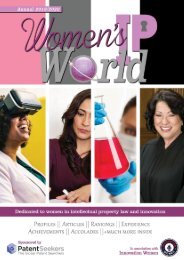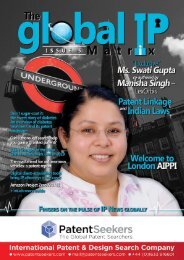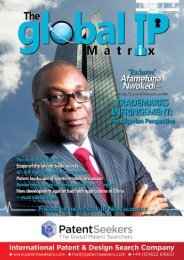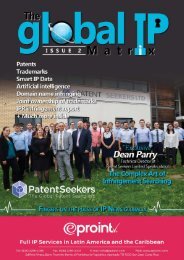Global IP Matrix - Issue 6
HAPPY NEW YEAR 2020 to all our readers. It has been a fantastic year for The Global IP Matrix, and 2020 is shaping up to become an even bigger and productive year for us. We have kept to our promise of giving our readers diverse news from the IP world straight from the frontline and hope you agree! We want to thank all our amazing contributors and give them credit for all the content they have submitted to us over the year. Without their expert knowledge, we would not be where we are today. We endeavor to provide our readers with engaging and up to date topics, written by specialists in the industry at all levels with an unbiased approach. Our ethos is ‘each one teach one', shared knowledge is key. We look forward to continuing to provide the right content to keep you wanting to read more in the coming year. Please enjoy this issue and look out for us again in a few months. From all of us at The Global IP Matrix & Northon’s Media, PR & Marketing
HAPPY NEW YEAR 2020 to all our readers.
It has been a fantastic year for The Global IP Matrix, and 2020 is shaping up to become an even bigger and productive year for us. We have kept to our promise of giving our readers diverse news from the IP world straight from the frontline and hope you agree!
We want to thank all our amazing contributors and give them credit for all the content they have submitted to us over the year. Without their expert knowledge, we would not be where we are today.
We endeavor to provide our readers with engaging and up to date topics, written by specialists in the industry at all levels with an unbiased approach. Our ethos is ‘each one teach one', shared knowledge is key.
We look forward to continuing to provide the right content to keep you wanting to read more in the coming year. Please enjoy this issue and look out for us again in a few months.
From all of us at The Global IP Matrix & Northon’s Media, PR & Marketing
Create successful ePaper yourself
Turn your PDF publications into a flip-book with our unique Google optimized e-Paper software.
Asimov and the
Patenting of Ethical Robots
January 2nd, 2020 marks the
centenary of the birth of Isaac Asimov,
the prolific science fiction writer
known to millions as the author of the
Foundation stories of Galactic Empire
and for his statement of the Three
Laws of Robotics, which in various
forms inspired dozens of his robot
stories, and influenced the work of
many other writers and film-makers.
The Three Laws of
Robotics are:
First Law
A robot may not injure a human being
or, through inaction, allow a human being
to come to harm.
Second Law
A robot must obey the orders given it
by human beings except where such orders
would conflict with the First Law.
Third Law
A robot must protect its own existence
as long as such protection does not conflict
with the First or Second Laws. 1
It is not difficult to appreciate the simple power
of this hierarchy of laws, nor the huge ambiguity
they allow. For example, in the Second Law,
which humans are to be obeyed? The fertility
of this formulation and the variations it has
engendered have proved inexhaustible.
As patent searchers, we were interested to see
the extent to which the Three Laws and other
ethical considerations appear in the patent
literature on robotics and artificial intelligence
(AI). We appreciated that a great deal of the
intellectual property in the ethics of AI would
reside in copyright rather than in patents, but
thought the exploration on the patent side
might provide some information not to be
found elsewhere.
Method of search
The search aimed to find patents that fell
under both of the search concepts AI (robots,
artificial intelligence, machine learning,
etc) and ETHICS. As the ETHICS concept
would almost certainly have to be specified
by Victor Green and Kaj Mahendiran
Victor Green & Company - Patent Information Analysts
www.victorgreen.co.uk
by keywords, we elected to combine it with
patent classes for the AI concept rather than
with keywords, so as to be bound within a high
relevance context. The two Cooperation Patent
Classification (CPC) classes defined below
seemed a good place to start:
1. Artificial life, i.e., computers
simulating life
2. Based on physical entities controlled
by simulated intelligence to replicate
intelligent life forms, e.g., robots
replicating pets or humans in their
appearance or behaviour
We used about 50 different expressions to
capture the ETHICS concept. MORAL* and
ETHIC*, of course, but ranging further from
ASHAMED and ASIMOV via LETHAL*
and OBLIGATION* to UNINTENDED
CONSEQUENCES and WAR.
The retrieval was then examined to find
candidates for discussion and analysis
and to use them to identify further patent
classification terms of interest. Five more
classes were chosen for combination with the
ETHICS concept that can be summarised as:
3. Programme-controlled manipulators,
characterised by learning, adaptive,
model-based, or rule-based expert
control
4. Robotics programme-control systems
which learn by operator observation,
symbiosis, showing or watching
5. Control of position, course or altitude
of land, water, air, or space vehicles,
e.g., automatic pilot, characterised
by the autonomous decision-making
process, e.g., artificial intelligence,
predefined behaviours
6. Computer systems based on simulated
virtual individual or collective
life forms, e.g., single avatar, social
simulations, virtual worlds or particle
swarm optimisation
7. Computer systems using neural
network models
These do not, of course, exhaust the classes that
might profitably be used in such a combination.
PATENTS
Some 550 patents were retrieved, of which
about 50 were considered relevant for the
subject. (This is a fairly typical relevance/
retrieval ratio for a landscape using our
approach to searching).
The Three Laws and AI
We reviewed these cases with the aim of
identifying the main themes occurring in the
patent literature, and in particular, the extent
to which one or more of the Three Laws might
be applicable to the inventions.
Fig. 1 Behaviour controlling system
and behaviour controlling method
for robot, US2005197739, Sony,
September 8th, 2005
Patents are filed to protect rights that may be commercially or industrially valuable, so perhaps
there should be no surprise to find so many concerned with the behaviour of autonomously
driven road vehicles, a growing, and potentially transformative industry. These amounted to
one-third of the selection. One recent application that took the eye, US 2019179306 assigned
to Evexia Research, aims to prevent a driver using a vehicle as a weapon against pedestrians by
simultaneously interpreting acoustic and accelerometer signals to detect actions such as high
speed kerb-mounting, following which an unmodifiable algorithm brings the vehicle to the safest
stop available, raises the windows, locks the doors and disables the accelerator.
Another five or so were also dedicated to specific applications such as prosthetic limbs preventing
motions harmful to the patient’s body, home robots acting in relatively uncontrolled spaces, a
global telecommunication system, and a system for managing training programmes that simulate
human behaviour in considerable detail (see Boeing’s granted patent US 7983996). Another five
prioritised the self-preservation of the AI system; in other words, they were almost exclusively
implementations of the Third Law.
The remainder, about half, were mainly concerned with the social and emotional behaviour of
intelligent systems, that is, aiming to enhance their interaction with human beings and human
society.
The following graphic shows the pattern in time of the applications filed, and of the number of
patents granted.
Fig. 2 Top 20 jurisdictions by families, applications and grants
Fig. 2 Patent application and grant velocity for AI and ethics
This shows a rise in filings from 2006 to 2007, then a slump coinciding with the financial crisis,
followed by a much higher filing rate from 2015.
Three cases explicitly invoked Asimov or the Three Laws of Robotics, and these tend to have very
ambitious claims. Consider, for example, Alan Kadin’s application US 2019258254 on a machine
that constructs a virtual reality environment in which it can plan and implement goals:
… a conscious machine aware of its self, comprising: a set of sensor inputs from an environment;
an artificial neural network, receiving the set of sensor inputs, and being configured to identify
the self, agents, and objects represented in the set of sensor inputs, recognise correlated patterns in
time and space in the environment, and plan achievement of a goal; and at least one automated
processor, configured to construct a simplified dynamical predictive model of the environment
that includes the self, interacting with the agents and the objects; a set of control outputs from the
artificial neural network, dependent on the simplified dynamical predictive model, configured to
alter the environment to implement the plan for achievement of the goal.
Of the 11 cases to which only the First Law of Robotics seemed to apply - protecting a human - 10
were autonomously driven vehicles and one an emergency landing system for aircraft.
A further four cases, that appear to involve all three of the Laws of Robotics, build complex
models of robot emotions as in Boeing’s patent mentioned above, and contain modules which
balance the requirements of the system against those of the human user, stated for example in
Sony’s US 2005197739 as:
… a behaviour control system and a behaviour control for the robot apparatus, having the
function of adaptively switching between the behaviour selection standard taking the self-state
into account, as required of the autonomous robot apparatus, and the behaviour selection
standard taking the counterpart [human] state into account, depending on a prevailing situation.
These often incorporate scenarios within
which the AI system will act. US 2014288704
creates social robotic characters which may
have a physical embodiment, that
…include behavioural provisions for
some important but unlikely short-term
interactive scenarios that could arise
quickly, such as those involving emotional
or practical support for users known to be at
risk for distress, such as users diagnosed with
dementia or autism.
Conclusion
The growth in applications since 2015 has
its origins in the deep learning revolution
dating from about 2012 that resulted
from the use of multilayer artificial
neural networks to solve problems and
outperform humans in fields such as
beating the world champion in the game
Go, visual pattern recognition e.g. for
cancer diagnosis, and predicting protein
folding and chemical targets for drugs. 2
How will controls on robot behaviour
such as Asimov’s laws be brought to
have their effect when the processes by
which the robots arrive at their decisions
are no longer detectable by humans as
was the case in purely rule-governed
AI systems? Perhaps we will just make
a leap of faith and come to trust such
“electronic persons” from our experience
in interacting with them, as forecast in
Steiner and Unbehaun’s application US
2018012133.
100 years on from Asimov’s birth and
nearly 80 years since he first articulated
the Three Laws of Robotics, we may
finally be entering the future he created
for us.
1
Asimov, Isaac (1950). “Runaround”.
I, Robot (The Isaac Asimov Collection
ed.). New York City: Doubleday. p. 40.
ISBN 978-0-385-42304-5.
2 “Why Deep Learning Is Suddenly
Changing Your Life”. Fortune. 2016.
Retrieved December 1st 2019.
22 www.gipmatrix.com
www.gipmatrix.com
23












